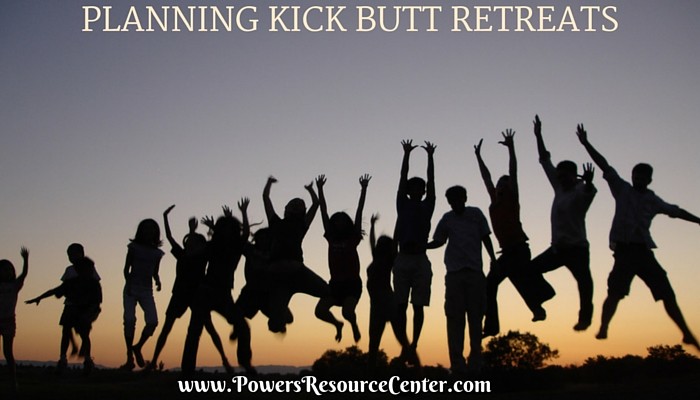by Tara Powers
Often business retreats can get a bad rap by employees because prior experience has proven that they really don’t have any positive changes in the workplace. Many times retreats are held for the wrong reasons or are labeled as a “retreat” when truly it’s just a company party, picnic, team get-together, or executive briefing session. In this article, we will help you discover when a retreat is a good idea for your business, what type of retreat is appropriate and what format you should follow to plan a retreat that has a positive impact for your business.
When a Retreat is a Good Idea
A well-designed retreat can achieve great things for your business. It can help to change strategic direction, solve significant business issues, create new ways of working together and contribute to developing a healthier culture for your organization. Check out the top reasons listed below to hold a retreat to determine if it’s the right decision for your business.
- A tough decision needs to be made about direction, staff, customers, products or service and you would benefit from the input of many people at different levels of the organization to make the decision.
- To build commitment to a vision for the organization and create alignment and accountability for achieving that vision.
- To explore significant business issues or concerns such as low morale, an increase in customer complaints or a drop-off in sales.
- To promote new ways of doing business, designing products, offering service or marketing. A retreat can help create understanding and commitment to a new direction.
- To generate innovate ideas for new products, services or business processes.
- To change perceptions, attitudes and behaviors that are harmful to the organization. A retreat can allow staff to discuss concerns, answer questions and clear up misunderstandings.
- To improve relationships on a team or between departments or divisions.
- To correct or change course when things are going wrong.
- To determine business strategy both short and long term.
What Type of Retreat You Should Choose
The type of retreat that you choose will impact your planning and design for the retreat. The most common retreats are listed below.
- Executive – top leaders convene to set strategy, measure progress, build trust, establish new priorities or make key decisions.
- Board/Staff – used to align actions of the staff with the priorities set by the board.
- Departmental – used when a new leader takes over, departmental changes and strategy is shifting.
- Interdepartmental – more than one department join together to find better ways of working together.
- Teamwork – used to build trust and improve relationships for a work team, project team or departmental team.
- Customer or Vendor – used to strengthen relationships with key customers or vendors.
- Workforce/Stakeholders – This involves bringing everyone together to reach understanding of key issues and foster better relationships.
What Format Your Retreat Should Follow
Most organizations will custom design a retreat to address specific concerns. However, specialized retreat formats exist than can be helpful in achieving desired results. Listed here are several specialized retreat formats to consider for your next retreat. They usually require a facilitator that is trained in their methodology to be effective.
- Large System Interventions – A large group of various stakeholders work through a predesigned methodolgy.
- Open Space Technology – Participants design their own agenda at the retreat.
- World Cafe – A round robin format of conversations take place on a variety of topics.
- Simulations – Realistic business exercises are designed to help an organization work through actual issues.
- Appreciative Inquiry – Questions are used to help participants create plans for the future by considering past successes.
- Experiential/Outdoor – Participants engage in exercises or activities that challenge them physically and mentally and require teamwork.
- Work-Out – This process guides participants to suggest performance improvements for the business.
As you can tell, there are important things to consider when planning a successful retreat. At PRC we are experienced in discovering if a retreat is right for your business and designing and facilitating a retreat that will produce results. Consider partnering with us to plan your next retreat.
Related Posts
-
Setting Team Expectations
It seems like the simplest thing in the world – setting team expectations. It’s Manager 101, right? So why then is there so much confusion – from both leaders and team members – about what is expected of them? A recent Gallup study found nearly…
-
Setting Team Expectations
It seems like the simplest thing in the world – setting team expectations. It’s Manager 101, right? So why then is there so much confusion – from both leaders and team members – about what is expected of them? A recent Gallup study found nearly…






